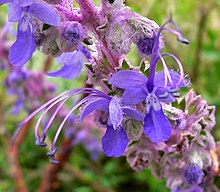| Trichostema lanatum | |
|---|---|

| |
| Scientific classification | |
| Kingdom: | Plantae |
| Clade: | Tracheophytes |
| Clade: | Angiosperms |
| Clade: | Eudicots |
| Clade: | Asterids |
| Order: | Lamiales |
| Family: | Lamiaceae |
| Genus: | Trichostema |
| Species: | T. lanatum |
| Binomial name | |
| Trichostema lanatum Benth. | |
Trichostema lanatum, the woolly bluecurls, is a small evergreen shrub or sub-shrub native to arid coastal chaparral regions of California down to the northern tip of Baja California.
Trichostema lanatum is many-branched and grows to 1.5 m (5 ft) tall, with narrow, pointed green leaves. The smooth-petaled blue flowers are borne in dense clusters, with the stem and calyces covered in woolly hairs of blue, pink, or white. Flowers are present from March to June.
Spanish explorers in California called the plant romero, the Spanish term for rosemary, and that common name is still sometimes used.
Uses
Trichostema lanatum is cultivated as an ornamental plant, and several cultivars have been developed. It attracts hummingbirds and bumblebees.
It is aromatic and glandular. Native Americans used it for a variety of medicinal and other purposes.
Its leaves and flowers make a flavorful tea.
Indigenous medicinal use
Trichostema lanatum was incorporated by the Chumash to help facilitate the healing process of menstruation and birth. When tested against an E.Coli ▵tolC mutant, woolly bluecurls (Trichostema lanatum) exhibited anti-bacterial properties. Studies have also shown anti-inflammatory properties against pro-inflammatory cytokine TNF-ɑ and anti-bacterial properties against macrophages and gram-postivie bacteria, corresponding with the use of woolly bluecurls (Trichostema lanatum) as a disinfectant and treatment for rheumatism by the Chumash peoples of California.
Trichostema lanceolatum was used by California Indigenous tribes in the form of tea or crushed leaves to treat a range of ailments including common olds, body aches, skin disorders, digestive problems, and malaria. Trichostema lanceolatum and Trichostema lanatum are both a part of the Lamiaceae family. They differ in smell, smell, and location found. Indigenous tribes used Trichostema lanatum to treat the same ailments as Trichostema lanceolatum. Woolly bluecurls (Trichostema lanatum) and other native plants have historically been used by Indigenous peoples in a holistic approach to medical care, which typically considers patient health and well-being at the intersection of biology, psychology, and culture, and manipulating the biochemical properties of native plants to treat the ailment.
Future studies of woolly bluecurls and other plants used by Indigenous peoples for medicinal purposes will need to focus on the use of such plants in a broader cultural system of care. Such work can be challenging, given the historical, systematic erasure of Indigenous wisdom that has been a primary function of settler colonialism.
References
- NRCS. "Trichostema lanatum". PLANTS Database. United States Department of Agriculture (USDA). Retrieved 14 December 2015.
- "Calflora: Trichostema lanatum". www.calflora.org. Retrieved 2017-06-16.
- ^ Rogers, D. (2001). Romero or Woolly Blue Curls. Double Cone Quarterly.
- Santa Monica Mountains Plant of the Month Archived 2010-11-30 at the Wayback Machine
- Ethnobotany
- Adams, James D.; Garcia, Cecilia (March 2006). "Women's Health Among the Chumash". Evidence-Based Complementary and Alternative Medicine. 3 (1): 125–131. doi:10.1093/ecam/nek021. ISSN 1741-427X. PMC 1375244. PMID 16550233.
- Allison, Brittany J.; Allenby, Mark C.; Bryant, Shane S.; Min, Jae Eun; Hieromnimon, Mark; Joyner, P. Matthew (2017-03-19). "Antibacterial activity of fractions from three Chumash medicinal plant extracts and in vitro inhibition of the enzyme enoyl reductase by the flavonoid jaceosidin". Natural Product Research. 31 (6): 707–712. doi:10.1080/14786419.2016.1217201. ISSN 1478-6419. PMID 27482826. S2CID 45752002.
- Fleming, Matthew (2014-03-21). "Extracts of Trichostema lanatum inhibit the growth of gram-positive bacteria and an Escherichia coli ΔtolC mutant strain". Seaver College Research and Scholarly Achievement Symposium.
- Fleming, Matthew C.; Hester, Victoria; Allison, Brittany J.; Foster, Majie C.; Nofziger, Donna; Joyner, P. Matthew (2018-03-21). "Immunomodulatory and Antibacterial Properties of the Chumash Medicinal Plant Trichostema lanatum". Medicines. 5 (2): 25. doi:10.3390/medicines5020025. ISSN 2305-6320. PMC 6023444. PMID 29561753.
- ^ "USDA Plants Database". plants.usda.gov. Retrieved 2023-12-18.
- "Plant of the Month Page". Santa Monica Mountains Trails Council. Retrieved 2023-12-18.
- "bluecurls (Genus Trichostema)". iNaturalist. Retrieved 2023-12-18.
- Koithan, Mary; Farrell, Cynthia (2010-06-01). "Indigenous Native American Healing Traditions". The Journal for Nurse Practitioners. 6 (6): 477–478. doi:10.1016/j.nurpra.2010.03.016. ISSN 1555-4155. PMC 2913884. PMID 20689671.
External links
| Taxon identifiers | |
|---|---|
| Trichostema lanatum |
|
- Trichostema
- Flora of California
- Flora of Baja California
- Natural history of the California chaparral and woodlands
- Natural history of the California Coast Ranges
- Natural history of the Peninsular Ranges
- Natural history of the Santa Monica Mountains
- Natural history of the Transverse Ranges
- Plants used in traditional Native American medicine
- Bird food plants
- Garden plants of North America
- Drought-tolerant plants